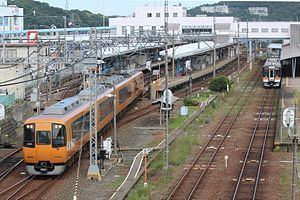Stations 5 | Termini UjiyamadaToba Opened March 1, 1970 Line length 13.2 km (8.2 mi) | |
 | ||
The Toba Line (鳥羽線, Toba-sen) is a railway line operated by the Japanese private railway company Kintetsu Railway, connecting Ujiyamada Station in Ise, Mie with Toba Station in Toba, Mie. The line runs parallel to JR Central's Sangū Line.
Contents
The line connects with the Yamada Line at Ujiyamada Station and the Shima Line at Toba Station. The Yamada Line, Toba Line, and Shima Line form a single train line that begins at Ise-Nakagawa Station and serves the Ise-Shima tourist region.
Service outline
LO Local (普通 futsū)
For Ise-Nakagawa For Toba, Kashikojima(Locals stop at every station.)
EX Express (急行 kyūkō)
RE Rapid Express (快速急行 kaisoku-kyūkō)
LE Limited Express (特急 tokkyū)
NS Non-stop Limited Express (ノンストップ特急 nonsutoppu tokkyū)
SV Premium Express Shimakaze (しまかぜ Shimakaze)
For Osaka Namba For Kyoto For Nagoya For Kashikojima(Train to and from Osaka runs once a day except on Tuesday with some exceptions.)(Train to and from Kyoto runs once a day except on Wednesday with some exceptions.)(Train to and from Nagoya runs once a day except on Thursday with some exceptions.)(Seat reservations, limited express fee and "Shimakaze" special vehicle fee required.)History
The Toba Line was constructed in the late 1960s / early 1970s to allow Kintetsu to run limited express trains from Osaka and Nagoya as far as Kashikojima in Shima. The decision to build the line was based on Kintetsu wanting to attract visitors from among the many people attending the 1970 World's Fair in Osaka to the Ise-Shima region where Kintetsu runs a variety of tourism business enterprises, and direct rail service would largely improve the bus system that was in place at that time, thereby making it more convenient to travel there.
The final link
Originally, what are now the Osaka Line and the Yamada Line were completed in the late 1920s / early 1930s by two separate companies, but both lines came under the control of Kintetsu in the 1940s. This made possible direct rail service from Osaka to Ise (at that time called Ujiyamada), primarily used by tourists and pilgrims going to Ise Grand Shrine. Also completed in the late 1920s was what is now the Shima Line which runs from Toba to Kashikojima. This line was built by a third independent railway company and went through the ownership of various companies over the years, finally falling under the umbrella of Kintetsu in 1965.
Kintetsu now owned train lines that stretched from both Osaka and Nagoya as far as Ise (Ujiyamada Station) as well as a small disconnected line running between Toba and Shima (Kashikojima Station), however there was no Kintetsu rail link between Ise and Toba, meaning Kintetsu passengers bound for Shima had to switch from train to a bus in Ise, then back to another train in Toba to complete the journey. The first solution, implemented in the 1960s, was building a bus ramp right up to the train platform of Ujiyamada Station and running buses that were timed to match up with the arriving limited expresses from Osaka and Nagoya, allowing passengers on those trains to easily switch to the bus without leaving the station or waiting long. However, in preparation for the 1970 World's Fair, Kintetsu decided it was a good time to implement the ideal solution which was direct rail access all the way to Kashikojima; thus the Toba Line was built to provide the final link.
Construction commenced in 1968 and a single track, connecting the Yamada Line and the Shima Line, was completed in 1970 just two weeks before the World's Fair began. Trains on this single-track Toba Line waited for each other to pass at a signal station located between Asama Station and Ikenoura Station near the line's midpoint. The line was officially completed when a second track was finished in 1975, thereby allowing bi-directional travel at all times.
